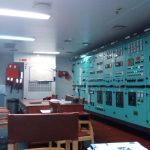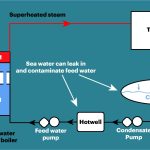Scavenge fires are caused by oil igniting at the combustion air inlet ports within the scavenge spaces on main engine diesel engines. They are frightening and dangerous, but they can be avoided by carrying out good watch keeping duties and regular maintenance of the fuel system and fuel injectors.
Scavenge fires are caused by lube-oil, diesel or heavy fuel oil gathering around the area of the scavenge ports. This is ignited by sparks form the combustion area passing the piston rings and coming in contact with the flammable oil. It is part of the watch keeping engineers remit to be familiar with the causes, control and prevention of scavenge fires in the main engine. It is also imperative that the scavenge spaces should be cleaned out at every opportunity in port and regular inspection of the scavenge drains to the sludge tank carried out by the watchkeeper.
The following sections examine scavenge fires and the actions required of the senior watch keeping engineer,
Watchkeeping Duties
The senior watchkeeping engineer on a main engine diesel engine should familiarise himself with the fuel system. This entails knowledge of how the fuel is purified by centrifuge and stored in the ready use tanks as well as the fuel pump and injection system. He should also be aware of the Chief Engineers standing orders regarding fuel oil injector nozzle cooling temperatures, fuel oil temperatures, fuel oil filter change intervals and maintain these as part of his watchkeeping duties.
Maintenance of Fuel Injectors
This is normally carried out by the third engineer; I used to do it whilst on watch during quite sea passages. I sailed with one Chief who insisted that the Second engineer carried out the maintenance. In any case the Chief or Second should at least witness the testing of the injectors.
The ship should carry plenty of spare fuel injectors; enough to change a couple at every port and leave a couple of spares to change after scavenge fires.
The spare injectors should be stored in racks with the nozzles well clear of the deck to prevent accidental knocks which can block the nozzle atomising holes.
The injector should be gripped in a vice which has jaw protectors and the nozzle removed. The parts should all be washed in diesel and any clinker carefully removed from the face of the nozzle with a copper scraper.
The nozzle should then be gripped in the vice and the needle ground into the seat using fine grinding paste. Once again wash the nozzle and needle carefully making sure all the grinding paste has been removed. Dry all parts and reassemble the injector, connecting the inlet to the injector testing pump outlet. Pump up the pressure to the recommended level and adjust the spring accordingly until the injector needle lifts and fuel is injected into a suitable receptacle.
At the recommended pressure the atomisation of the fuel should be visible and a squeak should be simultaneously heard. No dripping from the nozzle after atomisation is permitted.
Record the injector serial number, pressure that it lifted at and date of test, in the injector maintenance log and re-rack, ready for witnessing by the Chief or Second if required. Be sure to mark on the injector that it has been tested.
Finally, a word about safety – marine diesel engines fuel supply is at high pressure and if using heavy fuel oil will be very hot; I still have the scar on my wrist from an oil spill when I was changing an injector. That was 1967 when I was an engineer on a Sulzer engined Denholm Company Sulphur Tanker. Yuc! What a reek, glad I wasn’t a Deck Officer.
Also when testing a fuel valve on the test rig do not put you hands anywhere near the atomising fuel, and wear goggles!
A sketch of an injector and a scavenge space is shown below;


Checking Piston Ring Clearance and Cylinder Liner wear
Regular maintenance of the piston, rings and liners should be carried out, as per the Chief or Second engineers maintenance programme which will involve the periodic pulling of a piston (more so if a particular cylinder has a record of scavenge fires) and the examination of the rings and liners. A survey of these should be carried out to ensure that all components are within the makers recommended specs.
Rings should be checked for defects and clearances, liners being checked for scratching, wear and ovality.
Fuel system Maintenance
Regular purifying of the fuel oil by centrifuge, be it diesel or heavy fuel must be carried out to ensure an adequate clean supply of fuel for the main engine. I had trouble with scavenge fires on one ships engine and was getting a lot of stick as I maintained the fuel injectors. However we had a new Fourth who, against his Junior Engineers advice failed to clean the oil filters or centrifuges regularly. The dirty fuel blocked the injector nozzles causing them to leak after atomizing, resulting in scavenge fires. The junior finally came to me for advice; I promoted him and the Fourth got the boot at the next port and sent home – no more scavenge fires, so I cannot emphasis enough the importance of fuel oil filtering and centrifuging.
Good watchkeeping practices along with regular maintenance of the fuel oil system, regular checks carried out on main engine piston ring and liner clearances and the monitoring of lube oil usage will go some way to preventing scavenge fires in marine diesel engines.
Lube-oil Supply to Main Engine Cylinders
This used to be carried out by individual cylinder lubricators which had their reservoirs filled with lube oil every watch and pumped metered amounts of lube oil to the different cylinders, piped via quills in the cylinder walls. Nowadays I believe it is all part of the lube oil system, but the principles are probably similar. The main problem is over-lubrication, again whilst at sea we were experiencing high levels of lube oil usage, accompanied by scavenge fires. The lubricators supply oil to the cylinders through quills connected to the cylinder liner walls and the lubricators can be operated by hand if required. The culprit was an Indian greaser who whilst topping up the lubricators was merrily hand cranking away at the lubricators to get the level down so he could put a full Quart of oil in the reservoir! A quiet word in his lug and a boot up the whatsit sorted this one. So it is important to record the amount of lube oil being used per day by the main engine, and adjust the supply accordingly.
Other Miscellaneous Causes of Scavenge fire
· Exhaust poppet valve failure to totally close due to being coked up with carbon deposits. Very occasionally this occurs and immediate action must be taken to rectify the problem. (Nowadays, the valve stem has a fin welded onto it. the exhaust gases
· The grade of the fuel oil is important. This is the responsibility of the head office agent, but the chief is responsible to ensure bunkered oil is up to spec.
· Combustion air supply and temperature. This is supplied by the turbo-blowers, being filtered and cooled before delivery to the inlet ports. It is important that the ratio of fuel to combustion air is correct (around 14-1) but the Second will normally check this during his watch or when taking indicator cards.
Methods of extinguishing Scavenge Fires
Once a scavenge fire starts, hit the engine room emergency button, reduce the engine to its slowest possible revolutions this will limit the amount of fuel oil being admitted to the cylinders. It will also reduce the amount of combustion air to the cylinders, lowering the oxygen content being supplied to the scavenge fire.
The fuel must be isolated to the cylinder in which the fire is occurring by lifting the relative fuel pump plunger clear of the operating cam. The bridge should be informed and the engine room telegraph put to dead slow ahead, recording the times and the movements in the log book for future reference.
This may seem a lot to do at once, but I have had some serious scavenge fires while senior watch keeper on Sulzer two-stroke main engines and it can be done with a little help from the recently startled off-duty engineers (we have all been awakened by the banshee wail of the engine emergency siren and subsequent slowing down of the engine beat)
The watch keepers The senior engineer should remain at the controls, junior engineer adjusts the seawater to the lube oil and jacket coolers maintaining operating temperatures.
Other Engineers The rest of engineers should operate scavenge CO2 or mist sprays if fitted, Isolate the fuel by lifting the pump piston rod of the offending cylinders fuel pump cam, increases lube oil to that cylinder by hand operating the lubricator to prevent the piston seizing and, keep an eye on the exhaust condition out of the flu, scavenge door temperature and drains to sludge tank. Once the greasers have cleaned out the scavenge space, the senior engineer should inspect the piston rod and gland for signs of excessive scorching. The gland may need stripping if the springs holding the scraping rings have lost their tension through heat from the burning oil; excessive oil usually accumulating around this area. Excessive scorching will be evident by the blue color of the gland top keep ring and set screws.
Engine room Greasers – Once it has been determined that the fire has been extinguished, and the scavenge space has cooled enough for cleaning, the scavenge inspection doors should be slowly and carefully removed. The resultant carbon residue and fuel oil can now scraped away then cleaned using rags leaving the space dry and clean. The exhaust gas boiler should be fired up to maintain boiler steam pressure and the offending cylinder lube oil reservoir kept topped up.
Note: It is many, many years since I was a seagoing engineer, so please allow for a bit of age and alcohol related brain damage to this old retired Irish marine engineer, I would be pleased to answer any relevant queries through the comments section at the end of the article.


